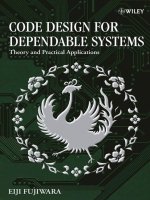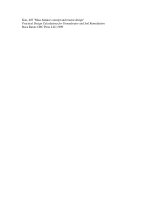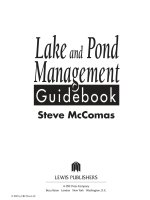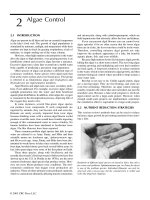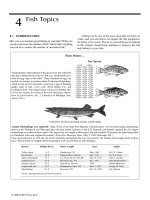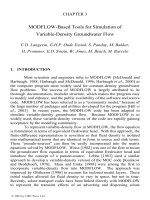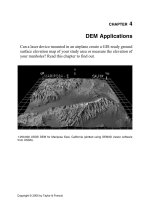WILDLIFE SCIENCE: LINKING ECOLOGICAL THEORY AND MANAGEMENT APPLICATIONS - CHAPTER 4 pps
Bạn đang xem bản rút gọn của tài liệu. Xem và tải ngay bản đầy đủ của tài liệu tại đây (966.94 KB, 13 trang )
4
Upland Game Bird
Management: Linking
Theory and Practice in
South Texas
Leonard A. Brennan, Fidel Hernández,
William P. Kuvlesky, Jr., and Fred S. Guthery
CONTENTS
Emerging Links between Theory and Management 66
Harvest Management 66
Empirical Example 67
Research and Data Needs 68
Culture and Perception 68
Hunter–Covey Interface Models 69
Static Models 69
Dynamic Models 69
Assumptions 69
Role of Heat 70
Continental Scale 70
Local Scale 71
Nest Predation Dynamics and Usable Space 73
Predictions from Simulations 73
Habitat: The Conceptual Link between Theory and Application 76
Acknowledgments 76
References 77
During the past 50 years, the South Texas landscape has provided a rich laboratory for developing
a scientific basis for game bird management, primarily based on studies of northern bobwhites
(Colinus virginianus) (Brennan 1999; Hernandez et al. 2002). Beginning with landmark natural
history investigations (Lehmann 1984) and continuing with a series of rigorous empirical studies
and development of models by Guthery and his associates (Guthery 2002), the emphasis on quail
research innovation in the United States has clearly shifted from the southeastern states to Texas and
Oklahoma.
Few, if any, wildlife species other than perhaps white-tailed deer (Odocoileus virginianus)
have received research attention comparable to the northern bobwhite. For example, the recent
Technology of Bobwhite Management (Guthery 2002) contains conceptual, quantitative, and theor-
etical models of all aspects of bobwhite life history: Energetics and energy-based carrying capacity,
65
© 2008 by Taylor & Francis Group, LLC
66 Wildlife Science: Linking Ecological Theory and Management Applications
the physiological need for water, populationecology, viability and production, harvesttheory, hunter–
covey interface (HCI) theory, and theory of habitat management. Linking such theoretical models
with management practices remains a major challenge, but has the potential to address and clarify
issues that have important implications for game bird management policy and regulation.
EMERGING LINKS BETWEEN THEORY AND
MANAGEMENT
Presently, there are at least four emerging examples of links between theoretical models and game
bird management practices in South Texas:
1. Various scenarios using harvest theory management models seem to be useful in clarifying
the implications of an agency proposal to double the daily quail harvest in Texas.
2. Empirical data suggest that theoretical HCI models provide meaningful results that can
help manage harvest pressure while optimizing hunting opportunities.
3. Role of heat in regulating bobwhite populations has been given a new prominence in quail
management, both from a climactic perspective and from understanding how operative
temperatures canmake vast areas potentially lethal to bobwhitesduring significantperiods
of the day.
4. Simulation modeling to assess interactions among predation dynamics, usable space for
nesting, along with precipitation and heat, indicate that while modest increase in bob-
white population might be gained from nest predator control, annual production can be
devastated by only moderate decrease in nesting cover.
Aunifying theme emerging from thesefour examples is that conceptsrelated to habitat theory and
usable space remain the cornerstone of successful bobwhite management applications. The objective
of this chapter is to briefly review and describe how these four examples form a linkage between
theoretical ideas and applied management actions for sustaining wild quail populations and quail
hunting in South Texas. Given the space constraints of this chapter, it is impossible to address each
topic in depth. Rather, we focus on these four issues and the ways they serve as examples of how
theory and management can be linked for wildlife conservation.
HARVEST MANAGEMENT
The TexasQuail Conservation Initiative(TQCI) has beendeveloped to stabilize, increase, and restore
wild quail populations (Brennan et al. 2005). The foundation on which the TQCI is based is habitat.
The initiative recognizes that a great deal of usable space for quail has been lost across the Texas
landscape and that successful efforts to reverse the quail decline will mean delivery of programs that
result in net gains of habitat for quail.
Despite the appropriate focus of the TQCI on habitat, administrators and politicians in Texas
attempted to promote doubling the daily quail bag limit from 15 to 30 birds as an incentive to inspire
private landowners to implement habitat management. Rather than inspiring people to implement
habitat management, the proposal to double the daily bag limit for private property owners who
implement quail management backfired on its proponents. It sparked a vociferous public debate
about the impact of hunting, including bag limits, season length, and associated issues. Although the
intensity of opposition to the 30-bird daily bag limit caused the proposal to be withdrawn, it pointed
to a number of issues pertaining to quail harvest in general and shifted the debate to a new direction.
Opponents of the 30-bird daily quail bag limit argued that there was no biological basis for such a
proposition, which seems like an appealing argument until one considers that the present 15-bird per
day limit in Texas also has no biological basis, as do most other statewide daily bag limits for quail
© 2008 by Taylor & Francis Group, LLC
Upland Game Bird Management 67
(Williams et al. 2004). Fifteen birds per day is simply a number that is deemed an intuitive, happy
medium somewhere between zero (no hunting allowed) and infinity (no limit required) that provides
opportunities to maximize recreational quail hunting opportunities in a manner assumed consistent
with wise use and sustainability. In Texas, the 30-bird bag limit debate, as it became known, veered
into conceptual territory that began to address the question: What, exactly, were the biological bases
for setting a daily quail bag limit, or even a season length?
Although quail harvest management remains a contentious issue, recent syntheses of past work,
along with refinement of associated additive harvest models, appear to have added a bit of clarity
and new direction (Guthery 2002) to the debate. In its simplest form, the additive model appears as
Q
a
= V
o
+S
o
H
o
,
where Q
a
is the total mortality from start to end of the hunting period, H
o
is the hunting mortality rate
for a given hunting effort in a population not subject to natural mortality, V
o
is the natural mortality
rate in a population not subject to hunting mortality, and S
o
is the survival rate in a population not
subject to harvest.
Despite beingimperfect, theadditive modelcan be usedas a basis for approximatingharvest rates
on specific areas. Managers will need data on fall density, spring density, and fall-to-spring survival
(an approximate guess based on the previous year or a range of historical data) to make meaningful
harvest prescriptions that result in a predetermined spring density. Some simple assumptions about
percent summer population gain from breeding also need to be made.
EMPIRICAL EXAMPLE
Using a modification of the additive model, harvest prescriptions for specific areas can be calculated
based on
H = (T −N)(1 −N),
where H is the harvest rate, T is the total mortality over winter = (fall density − spring density
goal)/(fall density), and Nis the nonhunting winter mortality.
Assuming a fall density of 1 bird/acre (2.4 birds/ha) and a spring density goal of 0.5 bird/acre
(or about 1.2 birds/ha)
T = (1 −0.5)/1 = 0.5
N = 0.4.
Therefore,
H = (0.5 −0.4)/(1 −0.4) = 0.17 or a harvest rate of 17%.
If fall density estimates showed 1000 birds present on a 1000-acre pasture, the recommended harvest
for thatgiven hunting seasonwould be 170quail. Theoretically, it should notmatter much whenthose
170 birds were harvested during the hunting season, although it would probably be preferable to do
so during the early to middle part of the season to avoid potentially additive effects of late-season
hunting mortality. In contrast, given the current 15birds per day bag limit, anda 120-dayquail season
in Texas, it would take only 33 hunter-days at 15 birds/day to legally inflict local extinction on the
quail population in the 1000-acre pasture. Thus, implementing harvest management prescriptions,
that is, harvesting a given number of birds during the season based on calculations such as those
shown above, on specific areas indicates that not only would losses to hunting be potentially lower
than under the present policy, but hunting losses could also be tailored to year to year variation in
rainfall and associated habitat conditions that influence summer gain (Table 4.1).
© 2008 by Taylor & Francis Group, LLC
68 Wildlife Science: Linking Ecological Theory and Management Applications
TABLE 4.1
Quail Harvest Prescriptions on a Management Unit under Various Annual Environ-
mental Conditions
Recall from the text example the 17% harvest rate prescription to achieve a breeding population density of
0.5 bird/acre. Now, consider the following three different potential production scenarios for year 2:
Example 1: Good production
Breeding season gain of 100% =+500 birds
Start of next hunting season = 1000 birds
H = (0.5 −0.4)/(1 −0.4) for a harvest rate of 17% or 170 birds out of 1000
Example 2: Excellent production
Breeding season gain of 150% =+750 birds
Start of next hunting season = 1200 birds
Assuming a spring density management objective of 0.5 bird/acre, and a fall density of 1.2 birds/acre:
T = (1.2 −0.5)/(1.2) =0.58, and N = 0.4 (as noted in text); therefore,
H = (0.58 −0.4)/(1 −0.4) = 0.8/0.6 = 0.3 for a harvest rate of 30% or 360 birds out of 1200
Example 3: Low production
Breeding season gain of 50% =+250 birds
Start of next hunting season = 750 birds
Assuming a spring density management objective of 0.5 bird/acre, and a fall density of 0.75 birds/acre:
T = (0.75 −0.5)/(0.75) =0.33, and N = 0.4 (as noted in text); therefore,
H = (0.33 −0.4)/(1 −0.4) =−0.07/0.6 =−0.12 or no harvest
Note that under the three scenarios presented, both the total annual bag and harvest rate, covary as fall density changes
in relation to variation in breeding season gain.
RESEARCH AND DATA NEEDS
The data neededto implement prescriptionsfor quail harvestmanagement are atonce both simpleand
complex. They are simple in the sense that specific harvest quotas to achieve a breeding population
density are based on estimates of population density and fall-to-spring survival and some measure
of summer gain in relation to environmental conditions. They are complex in the dual sense that
(1) many factors can influence and bias estimates of population density and fall-to-spring survival,
and (2) most field managers find collecting such data challenging at best, and intimidating at worst.
Of course, there is also the potential for resentment among managers who would consider collecting
such data unnecessary, because they are entrenched in status quo.
CULTURE AND PERCEPTION
Application of harvest management prescriptions has not gained widespread acceptance as a means
of regulating quail hunting. First, it is a relatively new idea that is not well known by managers even
though the basic ideas behind it are based on landmark quail research (Errington 1945; Roseberry
and Klimstra 1984; Guthery 2002). Second, the incumbent data and associated work required for
collecting such data are a significant obstacle for many managers. Third, the theoretical lack of a
daily bag limit gives lay people the impression ofunlimited harvest opportunities when in fact annual
harvest will usually be more conservative than what is currently allowed. Some see a seasonal quota
based on harvest management prescriptions as an opportunity for hunters to be legally sanctioned
game hogs, when actually just the opposite is the case.
Despite the obstacles noted above, harvest management prescriptions will need to be considered
as we move towards new definitions of quail management in the twenty-first century. For example,
© 2008 by Taylor & Francis Group, LLC
Upland Game Bird Management 69
Williams et al. (2004) presented a compelling case for such a change in perspective. They argued that
quail habitat management efforts need to be scaled up from individual efforts on single properties
to coordinated efforts on regional cooperatives, and that quail hunting pressure needs to be scaled
down from statewide bag limits that have no biological basis to localized harvest prescriptions based
on meaningful and conservative seasonal quail hunting quotas designed to sustain populations.
HUNTER–COVEY INTERFACE MODELS
Quail hunting is a complex behavioral process that until recently did not seem amenable to quantific-
ation. However, application of static and dynamic approaches that identified data needed to describe
the HCI have appeared during the past decade (Radomsky and Guthery 2000; Guthery 2002) and
produce meaningful results and predictions when used with empirical data (Hardin et al. 2005).
The models on which HCI theory is based contain some of the same variables as those of
operations research in warfare. Fortunately, for hunters and pointing dogs, quail are quarry that
do not return fire. However, hunting is hunting whether you are after a submarine or a bobwhite.
The potential impacts of “friendly fire” (e.g., politicians accidentally shooting attorneys while quail
hunting) are not part of HCI theory.
STATIC MODELS
Application of static models based HCI theory has the potential to complement harvest management
prescriptions in that such models provide a mechanism to optimize hunting opportunities in a spatial
context through time. That is, by increasing or decreasing the rate at which the hunt takes place —
and by extension the rate at which coveys are encountered and birds are killed — harvest, and
harvest opportunities, can be modulated to potentially achieve a management outcome (Figure 4.1).
However, HCI is only about a decade old, and has been tested only on one area in South Texas
(Hardin et al. 2005), although a less formalized application of spatial data has been used to quantify
willow ptarmigan (Lagopus lagopus) hunting in Norway (Brøseth and Pederson 2000).
HCI theory has yet to become assimilated into the mainstream of quail management, despite
having potential as a tool for managing harvest pressure on intensively hunted areas. The quantitative
nature of HCI theory further contributes to maintaining its obscurity. Perhaps such issues will change
over time as wildlife managers become more comfortable with quantitative techniques or software
becomes available that will put a user-friendly face on implementing HCI theory for management.
DYNAMIC MODELS
In HCI theory, dynamic models are used to assess the role of how quails learn to avoid predators
and thus influence the outcome of the hunt. Any seasoned quail hunter appreciates that quail tend
to “flush wild” or “run wild” or otherwise seemingly increase their ability to avoid being shot at as
the quail hunting season progresses. It has been noted that there are at least four different scenarios
(Figure 4.2) that are related to the rate at which quail learn and the intensity at which hunting occurs
(Radomsky andGuthery 2000; Guthery 2002). Empiricaldata indicatethat bobwhites in South Texas
most likely fit a “low hunting intensity–low learning rate” scenario (Hardin et al. 2005) (Figure 4.3).
ASSUMPTIONS
One of the most fascinating aspects of HCI theory is that it produces meaningful predictions and
results when tested with empirical data, despite failure to meet underlying assumptions. The key
assumptions upon which HCI theory is based (Table 4.2) are seldom met under field conditions for
a variety of reasons. For example, the assumption that coveys are randomly distributed across the
landscape can be met during some years but not others (Figure 4.4).Additionally, the assumption that
© 2008 by Taylor & Francis Group, LLC
70 Wildlife Science: Linking Ecological Theory and Management Applications
0
5
10
15
20
25
30
35
40
45
7.44 9.14 10.85 12.55 14.26
Velocity (kph)
Daily harvest
w=96
w=82
w=69
w=55
w=42
(a)
(b)
(c)
(d)
(e)
(f)
0
10
20
30
40
50
60
5.28 7.50 9.72 11.94 14.16
Velocity (kph)
Daily harvest
w=42
w=55
w=69
w=96
w=82
0
5
10
15
20
25
30
35
40
7.44 9.14 10.85 12.55 14.26
Velocity (kph)
Daily harvest
w=96
w=82
w=69
w=55
w=42
0
5
10
15
20
25
30
35
40
45
50
5.28 7.50 9.72 11.94 14.16
Velocity (kph)
Daily harvest
w=42
w=55
w=69
w=96
w=82
0
5
10
15
20
25
30
35
7.44 9.14 10.85 12.55 14.26
Velocity (kph)
Daily harvest
w=96
w=82
w=69
w=55
w=42
0
5
10
15
20
25
30
35
40
45
5.28 7.50 9.72 11.94 14.16
Velocity (kph)
Daily harvest
w=96
w=82
w=42
w=55
w=69
FIGURE 4.1 Static model output from HCI analyses of quail hunting data. (From Hardin, J. B., et al. 2005.
J. Wildl. Manage. 69: 498. With permission.)
hunting patterns and areas covered during a hunt are not redundant is easily violated (Figure 4.5).
If nonredundancy is more or less constant, this would not affect correlations between empirical and
theoretical kill rates. If hunts are applied randomly to space, or some semblance thereof, HCI ought
to work, as it seems to work in line transect sampling.
Despite the difficulty in meeting assumptions, it seems that HCI theory is “robust” to violation
of the assumptions upon which it is based. This is a seemingly remarkable phenomenon that needs
to be tested with sensitivity analyses and additional simulations.
ROLE OF HEAT
Poultry scientists have long-recognized the deleterious effects ofexcess heat on laying chickenssuch
as declines in feed intake, egg production, eggshell thickness, and quality of yolk and albumin inside
the egg (Card and Nesheim 1972; North 1972). This was also noted in bobwhites more than three
decades ago (Case and Robel 1974). Thus, it is curious that, until recently, quail researchers ignored
heat as a factor that limits quail production (Guthery et al. 2000; Guthery 2002). In this section, we
explore two scale-dependent issues that relate to how heat affects quail populations, the first on a
continental scale in the context of climate change and global warming, and the second related to how
heat impacts usable habitat space on a local, fine-grained scale.
CONTINENTAL SCALE
By disrupting breeding and habitat use on a local scale, global warming could potentially contribute
to quail population declines on a continental scale. Although largely overlooked by most quail
© 2008 by Taylor & Francis Group, LLC
Upland Game Bird Management 71
0 15304560
Total
Low–low Low–high
Coveys
Naïve
Experienced
75 90
500
400
300
200
100
0
0 153045607590
15 30 45 60
High–high
Day Day
Day
ConveysConveys
Day
High–low
Coveys
75 90
500
400
300
200
100
0
0 153045607590
500
400
300
200
100
0
500
400
300
200
100
0
FIGURE 4.2 Dynamic model predictions of HCI theory. (From Radomsky, A. A., and F. S. Guthery. 2000.
In National Quail Symposium Proceedings. Brennan, L. A., et al. (eds), vol. 4. Tallahassee, FL: Tall Timbers
Research Station, p. 78. With permission.)
researchers, global warming has been hypothesized to be potentially responsible for long-term quail
declines (Guthery et al. 2000). Habitat loss and fragmentation are most frequently invoked as being
the cause of quail population declines, but some have noted (Guthery et al. 2000) that there are other
places where declines have occurred where there is no apparent loss of habitat. Intellectually, long-
term warming trends could potentially be responsible for quail population declines, at least from
the perspective of climate change as one in a series of multiple working hypotheses (Chamberlain
1890).
LOCAL SCALE
Few people seem to appreciate that quail are sensitive to operative temperatures >38.7
◦
C, that such
temperatures occur regularly at southern latitudes, and that operative temperatures greater than this
threshold can be lethal to quail (Figure 4.6). In the south, operative temperatures >45
◦
C regularly
occur at ground level during summer (Figure 4.7). At such temperatures, the heat intake exceeds
heat loss in the quail body and death can occur in <1h.
What thismeans from amanagement point ofview is thatshade from woodyor robust herbaceous
cover is critical for providing thermal refugia for quail during daily periods of peak temperature.
Thus, if a pasture has, for example, <20% woody cover, then >80% of the habitat at ground level
© 2008 by Taylor & Francis Group, LLC
72 Wildlife Science: Linking Ecological Theory and Management Applications
0
50
100
150
200
250
(a)
(b)
123456789101112131415161718192021222324252627282930
Hunt number over 120 day season
Coveys
Total
Naïve
Experienced
0
50
100
150
200
250
Coveys
Total
Naïve
Experienced
123456789101112131415161718192021222324252627282930
Hunt number over 120 day season
FIGURE 4.3 Dynamic model output from HCI analyses of quail hunting data. (From Hardin, J. B., et al.
2005. J. Wildl. Manage. 69:498. With permission.)
may not only be unusable, it may also be lethal for quail during most of a given summer day.
Empirical data support this theoretical assertion for quail in South Texas (Forrester et al. 1998). This
simple linkageamong heat, lethality, and lack of usable habitatspace isremarkably underappreciated
within many quail management circles, especially as related to how relatively short times of excess
heat exposure can be potentially lethal during extended periods of the day.
Along with such potential lethality, excess heat can also reduce the laying season for quail
by as much as 60 days, which of course will lead to drastic declines or even complete failure of
reproduction. However, we cannot at this time say this is a causal relation. There are certainly
© 2008 by Taylor & Francis Group, LLC
Upland Game Bird Management 73
TABLE 4.2
Assumptions of HCI Theory and Factors That Do and Do Not Allow Them to Be Met
Assumptions Factors
1. Hunting is not redundant (static and dynamic models) GPS data from hunting events document that hunting
dogs and quail-hunting trucks frequently cover the same
areas repeatedly
2. Coveys are randomly distributed over the hunting area
(static and dynamic models)
Data indicate that coveys can be randomly distributed
during years of high-population density (habitat
saturation) but not during years of low density
3. All coveys are naive at the beginning of the hunting
season (dynamic models)
Adult quail that have survived from previous years may
retain learned avoidance behaviors
4. There is a greater probability of flushing a naive covey
than an experienced on given an encounter (dynamic
models)
An unknown portion of the population that was
considered naive may have actually been experienced,
based on encounter rates
correlative relationships between excess heat and poor reproduction from Illinois, the Southeast, and
South Texas. All we know for sure is that hot summers are associated with low production and short
laying seasons.
NEST PREDATION DYNAMICS AND USABLE SPACE
Despite an omnibuslack of evidence, predators continueto bear morethan their share ofthe blame for
ongoing quail declines (Rollins and Carroll 2001). Few people, including many wildlife managers,
understand thatcorrelation does not imply causation. During recent decades, we have seen a dramatic
recovery of raptor populations and concomitant decline in quail numbers, yet there is no empirical
evidence that raptors are suppressing quail populations, despite what many quail enthusiasts might
think.
Nevertheless, predation remains an important life history component of quail, especially during
the nesting season. As ground nesters, quail are vulnerable to predation losses, and have evolved
important mechanisms (large clutch sizes, indeterminate laying, and multiple nesting attempts) to
cope with these losses. Furthermore, predation is a process that influences quail populations, but
people tend to perceive predation as an event, or perhaps as an unrelated series of events, which
leads to shortsighted and oversimplified perspectives.
To understand how predation as a process influences quail populations, it is necessary to accu-
mulate a large series of records of predation events. This is now possible using infrared video
camera technology (Staller et al. 2005; Rader 2006), which, among other things, has documented
that the bobwhite nest predator context is quite different between the southeastern United States
and South Texas. One promising development for advancing our understanding of predation as a
process that influences quail populations is the combination of inventory data on predation events
from the infrared cameras withsimulation modeling using systems analyses (Rader 2006).Asystems
model, based on difference equations that produce accurate empirical results, allows researchers to
conduct “what if?” thought experiments — or simulations — to explore various scenarios to examine
trade-offs among heat, precipitation, habitat structure, and nest predator reduction.
PREDICTIONS FROM SIMULATIONS
Based on simulation analyses, Rader (2006) observed that reduced nest-clump availability had the
greatest negative effect on quail populations by lowering median bobwhite densities 1.8 quail/ha
© 2008 by Taylor & Francis Group, LLC
74 Wildlife Science: Linking Ecological Theory and Management Applications
0 200 400 600 800 1000 1200 1400 1600 1800 2000
Nearest neighbor distance in meters
0
20
40
60
80
100
120
140
(a)
(b)
Number of observations
Random
Coveys
2001–2002 Hunting season
Random
Coveys
2002–2003 Hunting season
0 200 400 600 800 1000 1200 1400 1600 1800 2000 2200
Nearest neighbor distance in meters
0
20
40
60
80
100
120
140
160
180
200
Number of observations
FIGURE 4.4 Evidence for annual variation in random and nonrandom distribution of quail coveys. (From
Hardin, J. B., et al. 2005. J. Wildl. Manage. 69:498. With permission.)
(75%) from the baselinescenario. Simulationof eliminating losses to thetopthreepredatorsincreased
density by 1.3 quail/ha(54%) frombaselineconditions. Predator controlalsoindicatedsome potential
to mitigate the effects of low precipitation and extreme heat, but effects were not significant for the
reduced nest-clump availability scenario. Over time, bobwhite median densities for all scenarios,
except predator control, showed gradual declines from the initial density of 3.7 quail/ha.
Simulation analyses conducted by Rader (2006) provide insight into dynamics of the predation
process that are not directly amenable to field conditions or empirical manipulation. Rader’s (2006)
simulation results pointedtotheimportance of nest clumpdensityas the primary factorthatinfluences
quail population density. Furthermore, these results showed that predator reduction was secondary
in importance to nest clump density when it comes to producing quail, thus providing support for the
importance of habitat. From a practical standpoint, the simulation results provided by Rader (2006)
© 2008 by Taylor & Francis Group, LLC
Upland Game Bird Management 75
FIGURE 4.5 Example of how spatial redundancies in quail hunting can violate the assumption of no spatial
redundancies in HCI theory. (From Hardin, J. B., et al. 2005. J. Wildl. Manage. 69:498. With permission.)
400
350
300
250
Minutes to death
200
150
100
50
0
40 45 50
Operative temperature (c)
55 60
FIGURE 4.6 Approximate time to death from hyperthermia in 180-g northern bobwhites. (From Radomsky,
A. A., and F. S. Guthery. 2000. In National Quail Symposium Proceedings. Brennan, L. A., et al. (eds), vol. 4.
Tallahassee, FL: Tall Timbers Research Station, p. 78. With permission.)
support thephilosophy that it is far easier andmore economicalfor a manager interested in stabilizing
and increasing a quail population in South Texas to provide abundant, high-quality nesting cover
than it is to administer a pogrom against nest predators. From a metaphysical standpoint, Rader’s
(2006) results support conclusions made nearly three decades earlier by Beasom (1974) and Guthery
and Beasom (1977).
© 2008 by Taylor & Francis Group, LLC
76 Wildlife Science: Linking Ecological Theory and Management Applications
65
60
55
50
45
40
35
Operative temperature (C)
30
25
20
600 800 1000 1200
Hour of day
1400 1600 1800 2000
FIGURE 4.7 Hourly trends in operative temperature at ground level at a location in Webb County, Texas.
(From Radomsky, A. A., and F. S. Guthery. 2000. In National Quail Symposium Proceedings. Brennan, L. A.,
et al. (eds), vol. 4. Tallahassee, FL: Tall Timbers Research Station, p. 78. With permission.)
HABITAT: THE CONCEPTUAL LINK BETWEEN THEORY
AND APPLICATION
Habitat isthe common thread among the four quailexamples usedin this chapter to illustrate linkages
between theory and game bird management applications. For example, no amount of quail harvest
management of any kind can be possible in the absence of the habitat required to produce quail in
the first place. Habitat structure is the key element that can mitigate the potentially lethal effects of
heat, especially on a local scale — which is the scale at which management actions are conducted.
Habitat saturation, or the circumstances that result in a random distribution of coveys across a
landscape, is important to meeting a key assumption of HCI theory. Finally, simulation analyses
indicate that the reduction of predators — something that is extremely difficult and expensive —
results in only modest population increases. In contrast, the same series of simulation analyses
indicate that providing adequate nesting cover will result in a much better population response that
can mitigate the effects of predators, heat, and drought.
Although the importance of habitat is clearly not new (Guthery 1997), an appreciation of the
role habitat plays in the context of management is fundamental to understanding linkages between
theory and application (Block and Brennan 1994). Hutchinson (1965) used the title The Ecological
Theater and the Evolutionary Play to demonstrate linkages between theoretical ideas and real-world
observations in ecology. He used a wide, metaphorical array of stage and set props provided by
habitat as factors that introduce countless twists on a classic plot: The struggle for existence of
organisms in the natural world through space and time.
ACKNOWLEDGMENTS
We appreciate theeditorial guidance from T. Fulbrightand D. Hewitt thathelped improve this chapter.
Brennan and Hernandez were supported by the Richard M. Kleberg, Jr., Center for Quail Research,
and Guthery was supported by the Bollenbach Endowment for Quail Research at Oklahoma State
© 2008 by Taylor & Francis Group, LLC
Upland Game Bird Management 77
University. We especially thank M. J. Rader for sharing results from his unpublished dissertation,
and S. J. DeMaso for discussions regarding harvest management. This manuscript has been approved
for publication by Oklahoma State University.
REFERENCES
Beasom, S. L. 1974. Intensive short-term predator removal as a game management tool. Trans. N. Am. Wildl.
Nat. Res. Conf. 39:230.
Block, W. M., and L.A. Brennan. 1994. The habitat conceptinornithology:Theoryand application. Curr.Ornith.
10:63.
Brennan, L. A. 1999. Northern bobwhite. In Birds of North America. Poole, A. and Gill, F. (eds). Philadelphia:
The Birds of North America, Inc., No. 397.
Brennan, L. A., S. DeMaso, F. Guthery, J. Hardin, C. Kowaleski, S. Lerich, R. Perez, M. Porter, D. Rollins,
M. Sams, T. Trail, and D. Wilhelm. 2005. Where Have All the Quail Gone? A Proactive Approach
for Restoring Quail Populations by Improving Wildlife Habitat. Austin, TX: Texas Parks and Wildlife
Department.
Brøseth, H., and H. C. Pederson. 2000. Hunting effort and game vulnerability studies on a small scale: A new
technique combining radio-telemetry, GPS and GIS. J. Appl. Ecol. 37:182.
Card, L. E., and M. C. Nesheim. 1972. Poultry Production. Philadelphia, PA: Lea and Febiger.
Case, R. M., and R. J. Robel. 1974. Bioenergetics of the bobwhite. J. Wildl. Manage. 38:638.
Chamberlain, T. C. 1890. The method of multiple working hypotheses. Science 15:92.
Errington, P. L. 1945. Some contributions of a fifteen-year local study of the northern bobwhite to a knowledge
of population phenomena. Ecol. Monogr. 15:1.
Forrester, N. D., F. S. Guthery, S. D. Kopp, and W. E. Cohen. 1998. Operative temperature reduces habitat
space for northern bobwhite. J. Wildl. Manage. 62:1505.
Guthery, F. S. 1997. A philosophy of habitat management for northern bobwhites. J. Wildl. Manage. 61:291.
Guthery, F. S. 2002. The Technology of Bobwhite Management: The Theory behind the Practice. Ames, IA:
Iowa State Press.
Guthery, F. S., and S. L. Beasom. 1977. Responses of game and nongame wildlife to predator control in South
Texas. J. Range Manage. 30:404.
Guthery, F. S., N. D. Forrester, K. R. Nolte, W. E. Cohen, and W. P. Kuvlesky, Jr. 2000. Potential effects
of global warming on quail populations. In National Quail Symposium Proceedings. Brennan, L. A.,
W. E. Palmer, L. W. Burger, Jr, and T. L. Pruden, (eds). 2000. National Quail Symposium Proceedings.
vol. 5. Tallahassee, FL: Tall Timbers Research Station, p. 198.
Hardin, J. B., L. A. Brennan, F. Hernandez, E. J. Redeker, and W. P. Kuvlesky, Jr. 2005. Empirical tests of
hunter–covey interface models. J. Wildl. Manage. 69:498.
Hernandez, F., F. S. Guthery, and W. P. Kuvlesky, Jr. 2002. The legacy of bobwhite research in South Texas.
J. Wildl. Manage. 66:1.
Hutchinson, G. E. 1965. The Ecological Theater and the Evolutionary Play. New Haven, CT: Yale University
Press.
Lehmann, V. W. 1984. Bobwhites on the Rio Grande Plain of Texas. Texas: Texas A&M University Press.
North, M. O. 1972. Commercial Chicken Production Manual. Westport, CT: AVI Publishing Co.
Rader, M. J. 2006. Factors influencing nest success of northern bobwhites in southern Texas. PhD Dissertation,
Texas A&M University, Kingsville, TX.
Radomsky, A.A., and F. S. Guthery. 2000. Theory of the hunter–covey interface. In National Quail Symposium
Proceedings. Brennan, L. A., et al. (eds), vol. 4. Tallahassee, FL: Tall Timbers Research Station, 78.
Rollins, D., and J. P. Carroll. 2001. Impacts of predation on northern bobwhite and scaled quail. Wildl. Soc.
Bull. 29:39.
Roseberry, J. L., and W. D. Klimstra. 1984. Population Ecology of the Bobwhite. Southern Illinois, IL: Illinois
University Press.
Staller, E. L., W. E. Palmer, J. P. Carroll, R. P. Thornton, and D. C. Sisson. 2005. Identifying predators at
northern bobwhite nests. J. Wildl. Manage. 69:124.
Williams, C. K., F. S. Guthery, R. D. Applegate, and M. J. Peterson. 2004. The northern bobwhite decline:
Scaling our management for the twenty-first century. Wildl. Soc. Bull. 32:861.
© 2008 by Taylor & Francis Group, LLC
